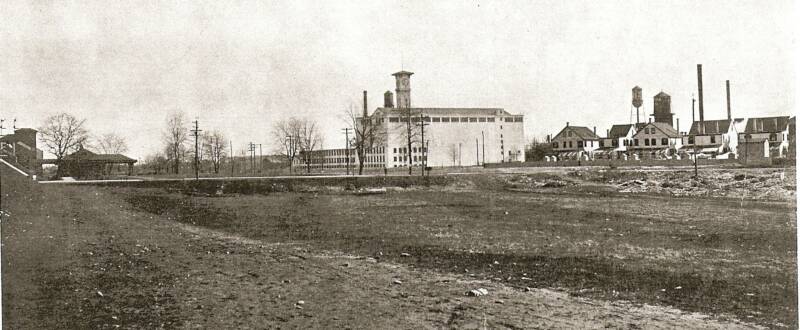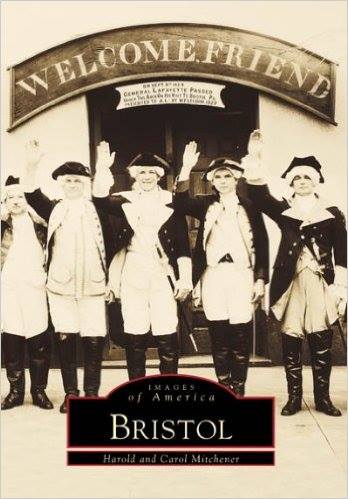Information Station- Revolution means Change
by Cate Murway
Bristol Borough, the only town of significance between the Delaware River and the county seat in Doylestown, and between Trenton and Philadelphia, used the power of the Industrial Revolution to catapult itself into a competitive world. The people and events changed people’s lives, contributing to the creation of an ethnically diverse industrial working class. What a plan! Functional innovation while delivering exceptionally valuable products!
This significant effect on the course of history brought on more technology, wealth and power.
“What do you do in an industry?” Harold Dodson Mitchener, BHS ‘56/WCU ‘60/ Masters in Geography and Social Studies from College of N.J. asked the attentive red shirted Snyder-Girotti students seated in the Margaret R. Grundy Memorial Library. “What’s a textile? Everyone put your hands on your shirt or blouse.” “Material!” shouts Jason.
Harold guides the obviously enthralled pupils through a basic overview of the Industrial Revolution and how this affected
the lives of ordinary people. He assists the 5th graders to understand working conditions and how the population was
changed forever by the quick succession of inventions and pieces of legislation. There is a golden thread that intertwines
unshakeable commitment to liberty with that of duty and social responsibility. This was modern America’s formative
period, when an agrarian society of small producers was transformed into an urban society dominated
by industrial corporations.
Harold and his wife, Carol, [valedictorian] Delhaas '56, Kutztown/ Masters El. Ed Boston U., distributed industry and transportation maps prepared by a cartographer in 1982. The maps identified the industrial district bordered by the former main line of the Pennsylvania Railroad on the southeast, Jefferson Avenue on the northeast, the former bed of the Delaware Division of the Pennsylvania Canal on the northwest, and Beaver Street on the southeast. Another map of the industries from 1885 represented the community’s history as a transportation and commercial center. The students identified the various modes of transportation including the river, the canal, the railroad and the automobiles to move products in and products out. Due to Bristol's excellent transportation facilities, it was ideal for a growing "mill-town”.
The students were requested to look for something red along the river and they happily located the Margaret R. Grundy Memorial Museum and Margaret R. Grundy Memorial Library. They were surprised to find that the Warren Snyder-John Girotti Elementary School is where the canal used to be.
Their lesson includes information about Joshua Pierce, who was instrumental in the transformation of Bristol from a canal-oriented town to a manufacturing center when he developed the Bristol Improvement Co. The original mills are shown on the maps. According to the The Bucks County Gazette, Bristol, PA 5 March 1896, the solid, mostly brick masonry Providence Hosiery Mills on Beaver & Buckley, belonging to the estate of Samuel Appleton were totally destroyed by fire.
The seven-story 13 building concrete Grundy Worsted Mill buildings, now the Grundy Commons, individually listed in the National Register of Historic Places, have been maintained to excellent integrity and continue to serve as the commercial, industrial hub and contribute to the architectural significance of the Borough. The Thomas L. Leedom Carpet Company Mill is now the location of the Grundy Recreation Center. The map is speckled with buildings representing the Corona Leather Mills, the Livingston [felt] Mills and the Keystone Mills that manufactured fringe and silk. The Canal Works was once the Wilson and Fennimore Wall Paper Company, then the David L. Landreth Seed Company and a radio factory.
The Mitcheners create all the visual aids, maps, and the question sheets and all kinds of teaching stuff to help make sure
learning is fun and effective.
They listened intently when the gilded age was explained, extravagant displays of wealth and excessive opulence of
America's upper-class who benefited from industrialization. The Gilded Age gets its name from the many great fortunes
created during this period and the way of life this wealth supported with the marked prosperity of business activity
and industrial development. The Industrial Revolution forever changed the framework of the world's economy,
culture and technology and these jobs allowed the average person to earn a wage that provided for them
beyond the essentials of living.
Then it’s time for the museum tour. Docent Alan Joseph Vogenberg, who obviously loves his work, said,
“Time flies when you’re having fun! The program is fantastic and a tribute to Donna McCloskey’s vision!
Every 5th grader in the borough learns the legacy of Senator Joseph R. Grundy (1863 - 1961).
The kids love it and learn their heritage!” His work ties in with the Mitchener’s class and he guides the interested pupils
through the Grundy family home that depicts genuine Victorian-era furnishings and décor. They are intrigued by the
burnished Sheffield silver and the jeweled glass window and are usually fascinated with the dumbwaiter.
Upon the Senator’s death in 1961, his Last Will & Testament established the Grundy Foundation, which carried
on his tradition of giving back to his community by directing that the 5 story [2 stories built into the river bank]
family home, situated along the banks of the Delaware River in Bristol Borough, becomes a museum of local history.
It is named in honor of his sister Margaret, who preceded him in death. The Margaret R. Grundy Memorial Museum
is open to the public at no charge.
Donna McCloskey, Grundy Museum Director; Mary Jane Mannherz, Grundy Library Director; Mary Gesualdi, Snyder-Girotti Elementary School; historians Harold and Carol Mitchener, Grundy Library/Museum volunteers and the Bristol Cultural and Historic Foundation met to discuss this pilot program for the fifth-grade Bristol Borough students. The focus is on the early industrial period in the Borough of Bristol and the Grundy family’s role in the town’s industrial growth. A comprehensive two-part tour was developed: the students would attend a workshop presented by the Mitcheners on industry in Bristol at the Library, followed by a guided tour of the Grundy family home.
According to reading specialist teacher and Title 1 federal program coordinator, Mary Gesualdi, “Harold IS Bristol’s history. His insight and wisdom impacts the students. He makes history come alive. He is a true treasure!”
Teachers, Joanne Matriana, BHS ’73 and Jenna Michele Settino, HST ’02 agree, “The kids really enjoy it and are excited
to participate. They know about the Industrial Revolution on a national level but are interested in relating it to the Borough.”
Donna McCloskey shared, “The students are very engaged during the tour, they ask a lot of relevant questions, and many return later for a visit with a parent or grandparent.”
The program is a total success and is now part of the innovative Borough curriculum.
To recommend a Bristol Bits Article to be spotlighted: email vjmrun@yahoo.com
Carol and Harold Mitchener



